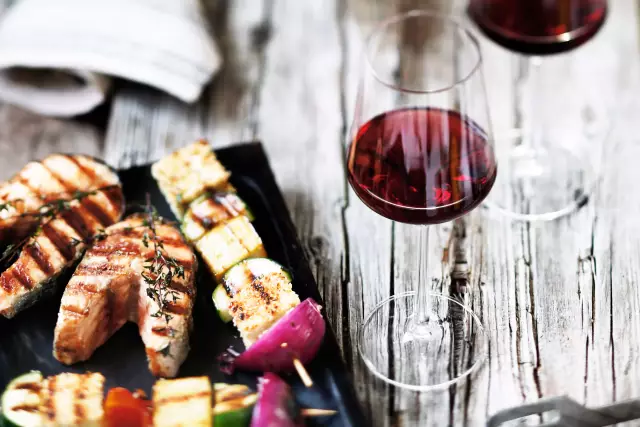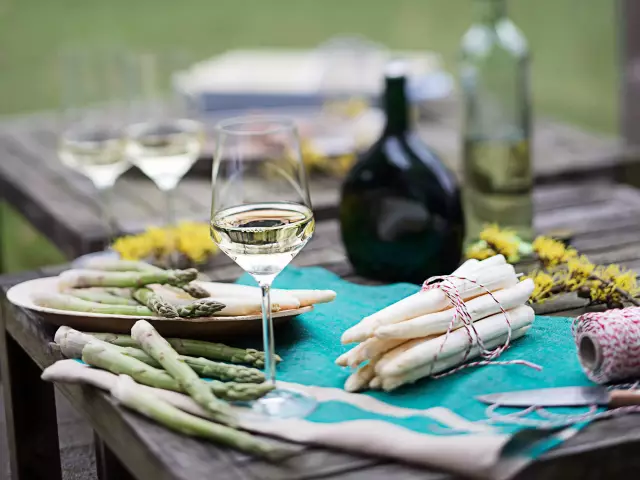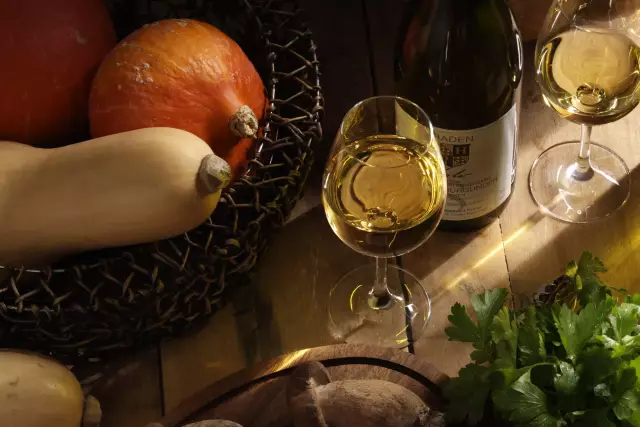Fondue & Wine

Long winter evenings and New Year’s Eve are excellent opportunities for a fondue or raclette in delightful company. And the enjoyment is enhanced if the culinary diversity is complemented by suitable wines. Ernst Büscher of Wines of Germany (DWI) recommends: “Ideally, you should already consider your guests’ wine preferences when you choose the style of the fondue.”
Facts
-
100 degrees
hot grease or broth
-
Infinite
variations to choose
A great variety of nuances is added by the many potential side dishes and condiments, which should also be considered when you chose a suitable wine. “The sauces are frequently more dominant in taste than the meat you are using,” Ernst Büscher explains. A fruity, slightly hot chutney, for instance, makes for a harmonious combination with a semi-dry Riesling. However, rich mayonnaise-based sauces correspond ideally with powerful Pinot Gris, and fragrant dips with an Asian touch like to enter into a playful liaison with fruity Pinot Blanc, Silvaner or a fresh Pinot Noir rosé.
The broad range of available fondues and raclettes offers a great diversity of exiting potential combinations with German wines. Wines of Germany (DWI) offers you a few guidelines for the suitable choice of wine:
Cheese fondue
is mostly prepared with melted Gruyère, white wine and spices. A powerful Pinot Gris or Pinot Blanc, for instance from Baden, is the right companion for this rich dish. Traditional side dishes for the cheese fondue are mixed pickles, small gherkins and sometimes Bündnerfleisch. The acidity of the pickles makes the fondue more easily digestible, but it has to be taken into account as well when choosing the right wine. The acidity is nicely offset by a Rheingau Riesling with a little residual sugar. This wine also adds a fresh touch when you’re enjoying the cheese all by itself.
Meat fondue
often offers a broad selection of beef, pork or poultry. The pieces of meat are cooked in hot oil and seasoned with a variety of dips. Within this broad range of aromas, a truly versatile wine such as a fruity-fresh Pinot Gris from the Pfalz is recommended. A Pinot Noir Weißherbst is another wine that can play alongside all kinds of meat fondue. Particular care needs to be taken if you’re serving hot dips. The spiciness increases the perception of alcohol. Thus hot dips should be accompanied by light wines such as Riesling or Pinot Blanc Kabinett. Suitable red wine companions for spicy dishes are Pinot Noir or Lemberger, for instance from Württemberg.
Chinese fondue
This variety uses a mild broth rather than hot oil. When cooked in the broth, the meat does not develop roast aromas and retains a milder taste. As a rule, the choice of dips reflects this mildness. A suitable wine should be able to play along with a broad range of aromas. A Silvaner or Portugieser Weißherbst from Rheinhessen is particularly suitable.
Fish fondue
a delicate variety of companionable enjoyment. In a fish fondue, you use firm-fleshed kinds of fish, but also prawns, shrimps or other seafood varieties. These are quickly cooked in a fish fond. In this case, wine recommendations focus on white wines, since their aromas are well suited to accompany the subtle diversity of aromas of the fish and dips. Classics such as Moselle Riesling are particularly good with zander, trout and redfish. Delicate monkfish and fresh prawns like to be accompanied by Pinot Blanc from the wine-growing regions Palatinate or Saale-Unstrut. In the company of richer dips – such as the popular aioli – a heartier Silvaner from Franconia works well.
Where does the term fondue come from?
Fondue derives from "fondre", French for "to melt", and is originally a dish with melted cheese.
Varietals

More recipe ideas
with honey and thyme Goat's cheese tower
with honey and thyme
- 1 großer Apfel
- 1 Rolle Ziegenkäse
- 4 Scheiben Bacon
- 4 TL Honig
- 1 TL Thymian
- 4 Blätter Eichblattsalat
- frische Zweige Thymian zum Garnieren
- nach Belieben Salz & Pfeffer
Preheat the grill to the highest setting.
Fry the bacon slices without fat in a non-stick frying pan until crispy and drain on a piece of kitchen paper. Leave the rendered fat in the pan.
Wash the apple, core it with a corer and then cut it into four, approx. 1 cm thick slices. Slowly fry the apple slices in the remaining bacon fat until just cooked, using the tip of a knife to check the doneness. Place the apple slices in a lightly greased baking dish, sprinkle with thyme and place a crispy fried bacon slice on top of each one.
Divide the goat's cheese into 4 thalers and place one thaler on each apple slice, sprinkle with thyme again and drizzle with 1 teaspoon of honey.
Bake under the grill until the cheese is lightly browned.
Serve the goat's cheese and apple tartlets on a lettuce leaf or, if you prefer, on a bed of lettuce (add a honey-flavoured dressing)
- Dornfelder (halbtrocken & feinherb)
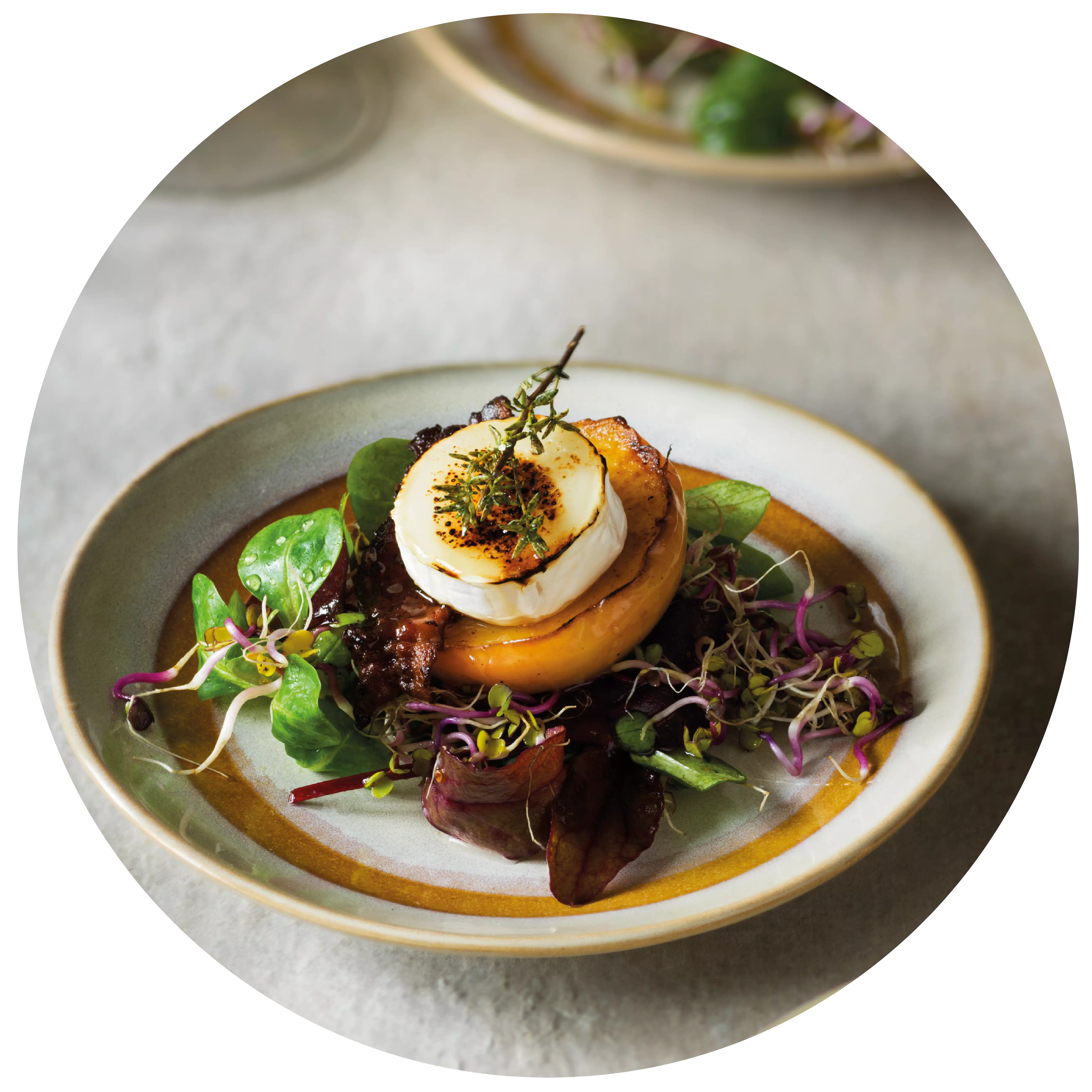
with bulgur Cabbage stew
with bulgur
- 200 Gramm Zwiebeln
- 1 ganze Knoblauchzehe
- 800 Gramm Spitzkohl
- 200 Gramm Möhren
- 400 Gramm festk. Kartoffeln
- 1 EL Kümmelsaat
- 1,5 Liter Gemüsefond
- 5 EL Olivenöl
- 2 EL Tomatenmark
- 2 EL edelsüßes Paprikapulver
- 3 TL Honig
- nach Belieben Salz & Pfeffer
- 120 Gramm grobe Bulgur
- 1 Bund Petersilie
- 4 Stiele Minze
- 1 ganze Zitrone
- 2 ganze Äpfel
- 3 EL Obstessig
Finely dice the onions and garlic. Clean, wash and quarter the cabbage, remove the stalk and roughly chop the cabbage quarters. Peel the carrots, halve lengthways and cut into approx. 2 cm wide pieces. Peel the potatoes and cut into approx. 2.5 cm pieces. Fry the carrots in a pan without fat and set aside.
Heat the vegetable stock in a small pan. Heat 3 tablespoons of oil in a large pan, sauté the cabbage in it for 10-15 minutes over a high heat until dark brown and remove from the pan.
Add the remaining oil to the pan. Fry the onions and garlic until translucent. Add the potatoes and muesli and sauté for 3-4 minutes, stirring constantly. Add the tomato purée and paprika powder and fry while stirring. Add the cabbage, honey and caraway and pour in the hot vegetable stock. Season with salt and pepper. Bring to the boil, cover and simmer for 45 minutes. Add the bulgur 20 minutes before the end of the cooking time.
Quarter the apples, remove the seeds, cut into approx. 1 cm cubes and add 10 minutes before the end of the cooking time. Pluck the herbs and chop medium-fine. Wash and dry the lemon, finely grate the zest and mix with the herbs. Flavour the stew with vinegar, salt and pepper and serve sprinkled with the herbs.
Tip: The pointed cabbage must be roasted really strongly and dark so that the aromas come out well.
- Spätburgunder / Pinot Noir (trocken)
- Trollinger (trocken)
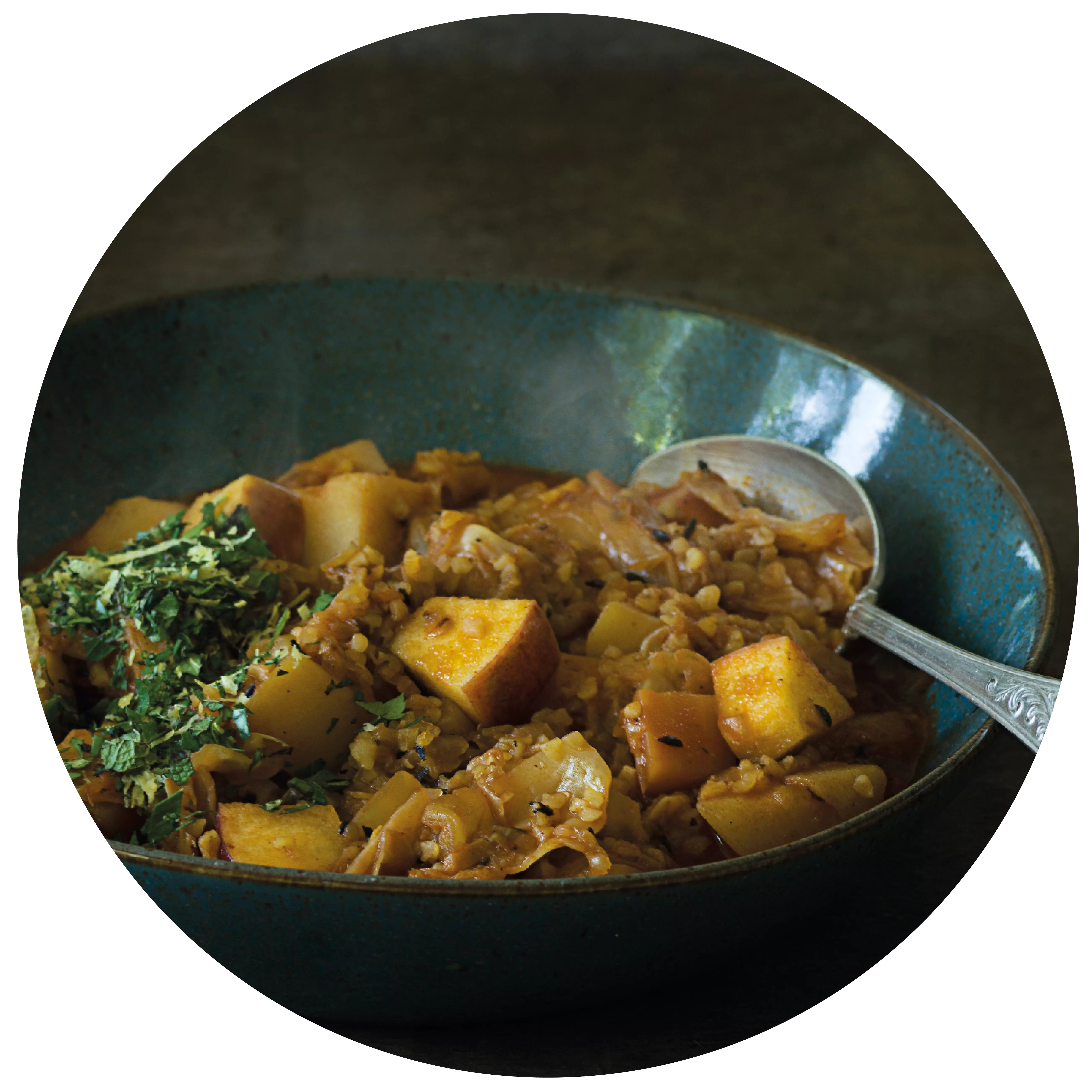
with semi-frozen goat's milk Lavender waffles
with semi-frozen goat's milk
- 2 Stück Eigelb
- 60 ml Ziegenmilch
- 500 Gramm weiße Kuvertüre
- 125 ml Sahne
- Abrieb und Saft einer halben Orange
- 2 cl Tresterbrand
- 8 Blatt Minze
- 125 Gramm Mehl
- 50 Gramm Zucker
- 70 Gramm Butter
- 2 Eier
- 1 Messerspitze Backpulver
- 1/2 EL Lavendelzucker
- 175 ml Milch
Semi-frozen goat's milk: Beat the egg yolks and goat's milk in a bowl over a hot bain-marie until creamy. Remove from the bain-marie and beat the cream until cold. Flavour with the zest of the orange and the marc brandy.
Liquefy the couverture in a bain-marie and stir into the lukewarm egg mixture. Whip the cream until stiff and carefully fold in. Line a parfait tin (triangular or gutter shape) with cling film. Pour in the mixture and smooth out. Cover well with cling film and leave to freeze in the freezer for at least 8 hours.
About 20 minutes before serving, remove the mould from the freezer and turn the parfait out of the mould. Remove the foil and cut the semi-frozen parfait into 8 slices.
<p
<p>Lavender wafers: Lightly mash the butter in a mixing bowl with a fork. Add the sugar and stir a little. Add half of the milk, the lavender sugar and the baking powder. Stir in the eggs and finally the rest of the milk. Mix everything well with a hand mixer for about 2 minutes to create a homogeneous, slightly liquid mixture. Bake the batter in batches in a waffle iron until golden brown.</p
<p>Arrange 2 slices of semifreddo on each waffle on a flat plate and decorate with mint leaves.
- Riesling (halbtrocken & feinherb)
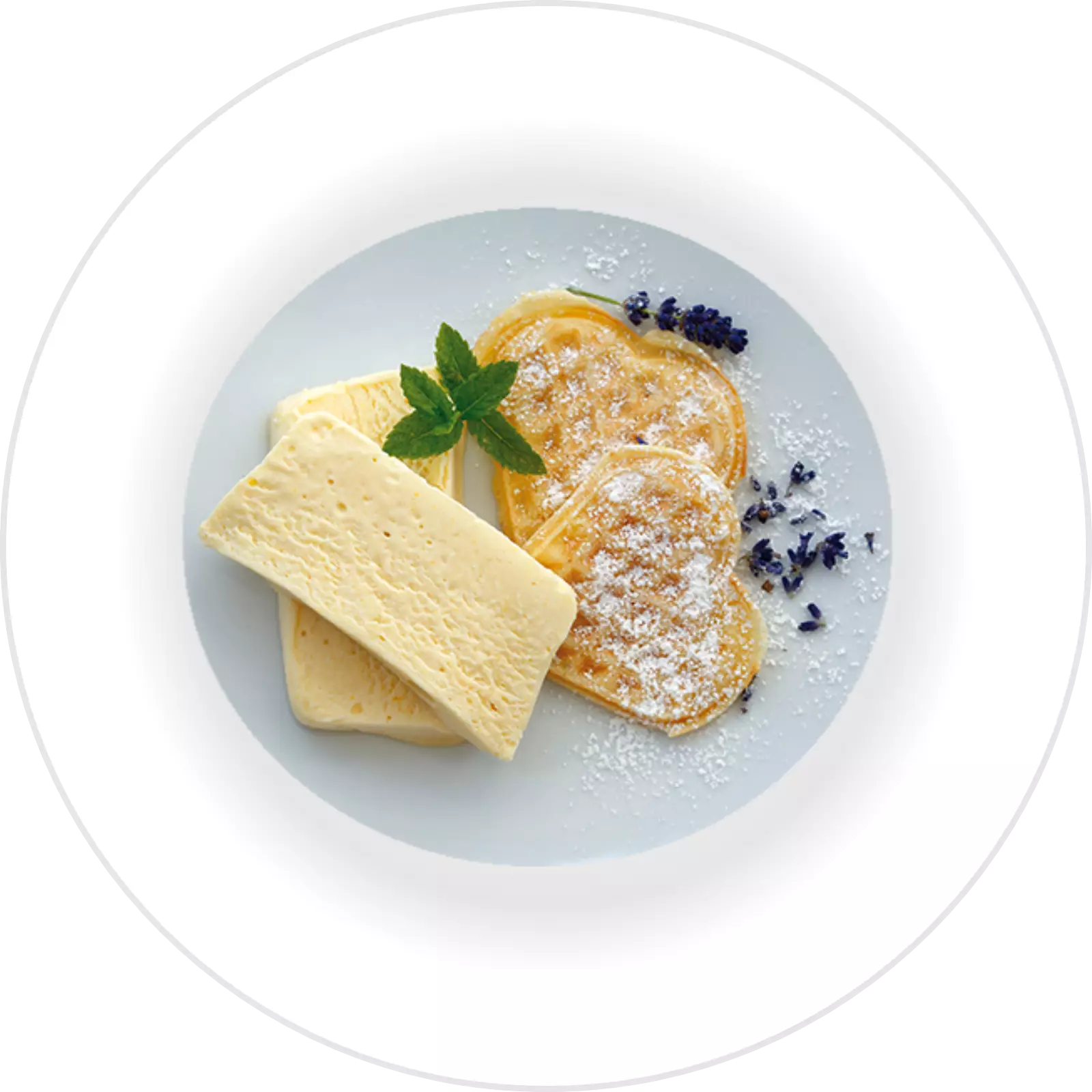
with strong red wine Wild boar ragout
with strong red wine
- 800 Gramm Fleisch vom Wildschwein (Keule o. Schulter)
- 80 Gramm Bauchspeck
- 100 Gramm Zwiebeln
- 60 Gramm Karotten
- 60 Gramm Staudensellerie
- 1 TL Tomatenmark
- 200 ml kräftigen Rotwein
- 100 ml Portwein
- 1 Liter braune Wildbrühe
- 1 TL Preiselbeeren
- 1 EL geschlagene Sahne o. Sauerrahm
- 20 Gramm Mehl
- 1 Stück Lorbeerblatt
- je 1 Zweig Rosmarin und Thymian
- 4 zerdrückte Wacholderbeeren
- 1/2 TL Senf
- nach Belieben Salz & Pfeffer
Clean and wash the vegetables and cut into evenly sized cubes.
Remove the fat, skin and tendons from the wild boar meat and cut into 3 cm cubes. Season with salt and pepper and sprinkle with flour. Heat the oil in a frying pan and brown the meat on all sides. Add the vegetables and diced bacon and fry. Add the tomato purée and stir fry. Deglaze with the red wine and port, reduce and pour in the brown game stock. Add the spices to the meat in a small spice bag and leave the ragout to simmer in the oven at 160°C for approx. 1½ hours.
Then remove the pieces of meat, remove the spices, strain the sauce, add the cranberries and mustard and leave to reduce for about 15 minutes. If necessary, thicken with a little cornflour. Serve with the whipped cream.
- Spätburgunder / Pinot Noir (trocken)
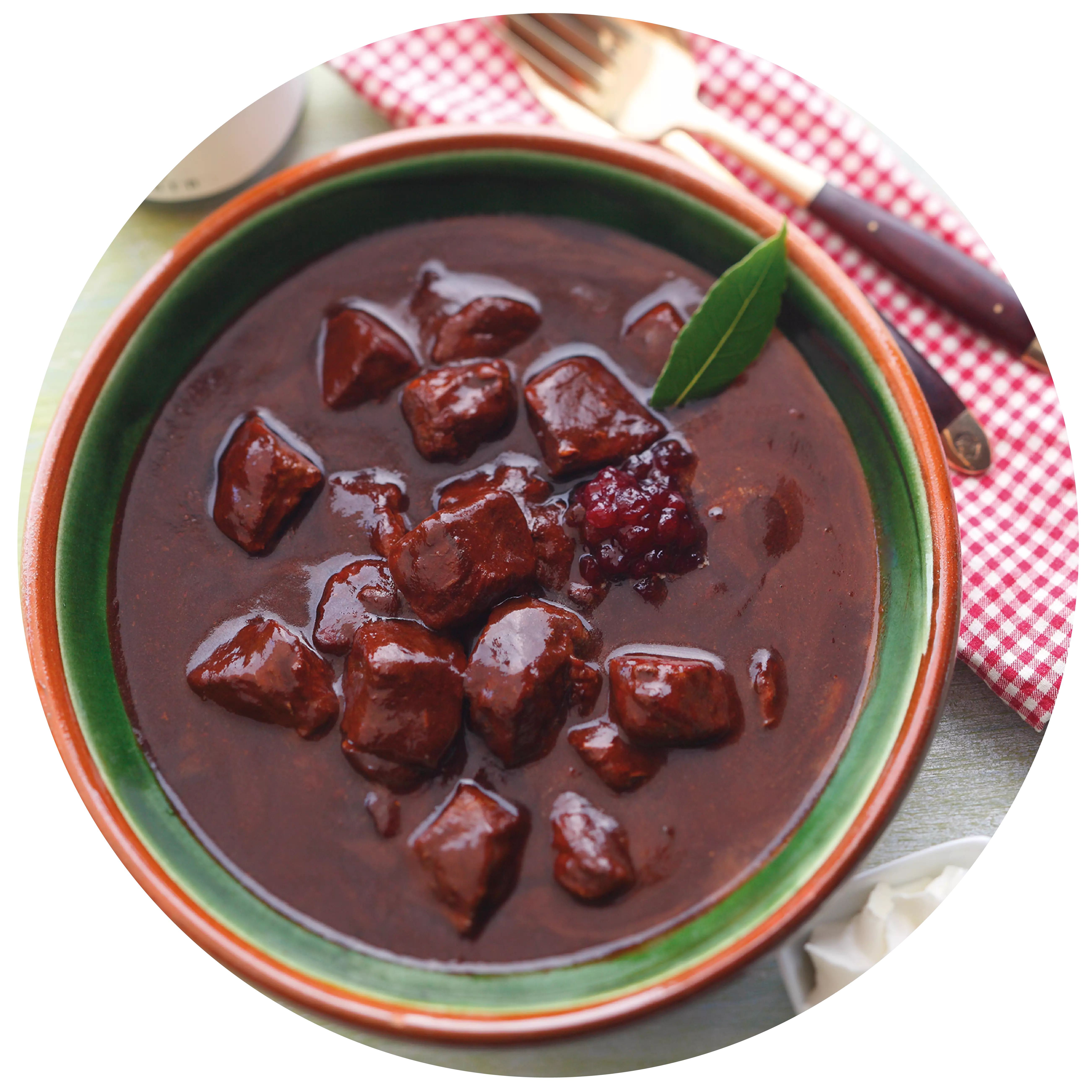
Events
-
Show
winetasting in our winery - blind tasting
Mainz-Hechtsheim


